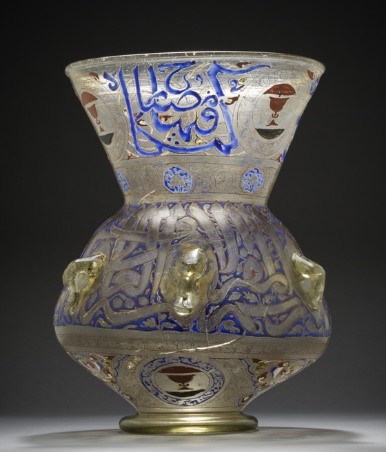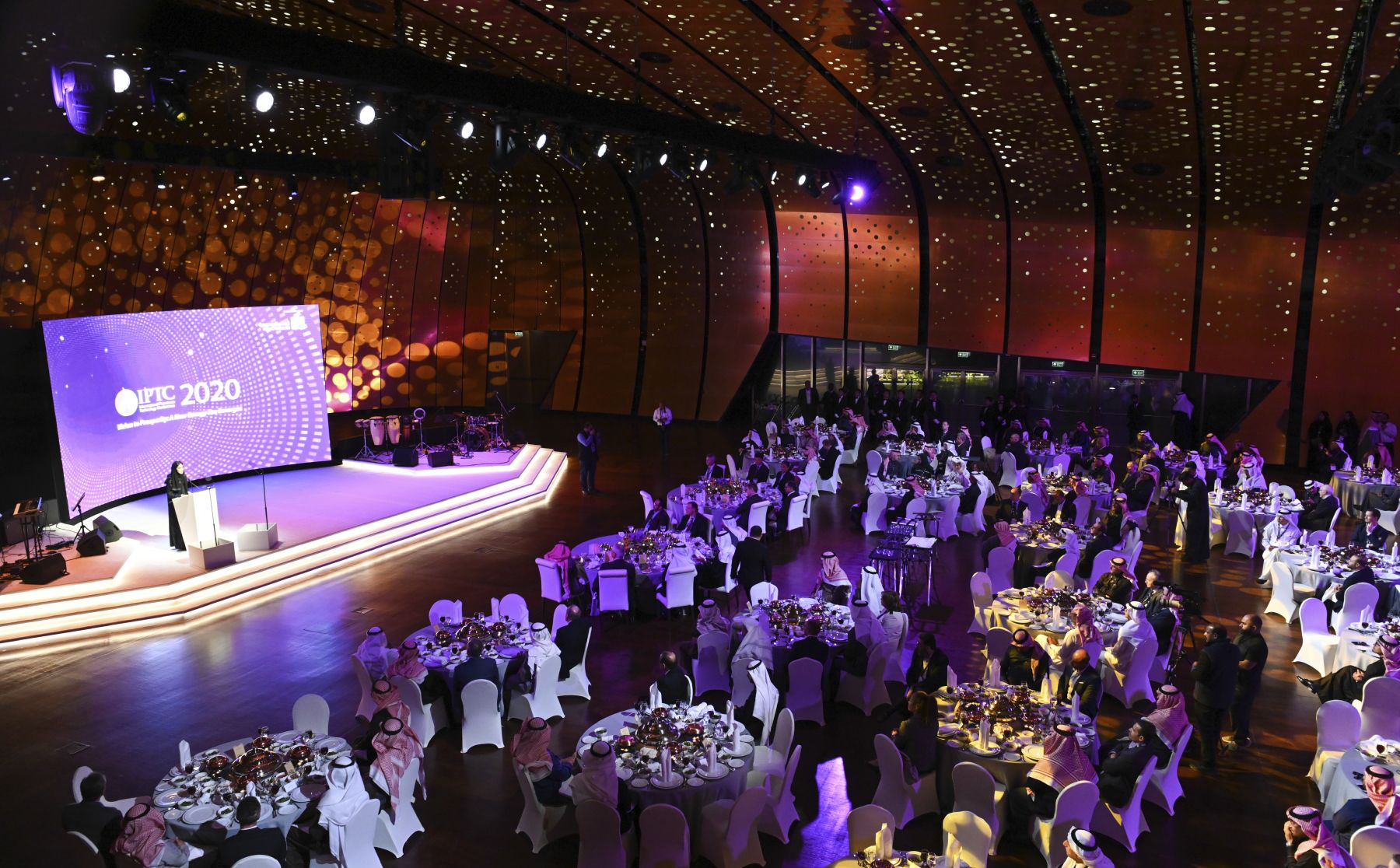
Lamp
Egypt or Syria, mid-14th century
Glass
Glass, free-blown and tooled, enameled and gilded
unspecified (unspecified): 13 9/16 x 11 1/4 in. (34.5 x 28.58 cm) Diameter (Diameter): 11 1/2 in.
Los Angeles County Museum of Art
William Randolph Hearst Collection (50.28.4)
Earth Hour
Earth Hour is held every year on the last Saturday of March. To show solidarity in support of our planet, people from virtually every country turn off their lights and switch to candles. Making a positive environmental impact is important for the King Abdulaziz Center for World Culture (Ithra). Ithra’s iconic building – which Time Magazine called Ithra one of “World’s Greatest Places” – was awarded Gold LEED certification (Leadership in Environment and Energy Design), a high-water mark of sustainable design.
In the spirit of Earth Hour and informed awareness, we are here taking a look at a large blown-glass lamp that was made in Syria or Egypt in the 1300s. It is now on view at Ithra as part of the exhibition Beauty and Identity: Islamic Art from the Los Angeles County Museum of Art.
As we consider Earth Hour and sustainability, this lamp is our candle.
Light, suspended: A 700 year-old blown glass mosque lamp
Time of day can be a clock thing described by hours and minutes. Or it can be something else: sunrise, sunset, noon and so on. Since the birth of Islam, the muezzin has announced the call to prayer five times a day: dawn, midday, afternoon, sunset and evening. These are not clock times. They reflect our position on the Earth in relation to the sun. Three of these times involve darkness: the dark that precedes the dawn and follows sunset. It defines evening as well.
Before electric lights, how did people read the Qur’an in the dark? How did they see?
Oil lamps were one solution. We often see the small clay or metal lamps with a handle at one end and an opening for a wick at the other. But to light a large public space? More was needed. Much more.
During the 1300s in the Arab World, the solution was large blown glass oil lamps that were suspended from the ceiling by chains. Oil was poured over water (oil is lighter – it floats) both to protect the lamp if the oil ran out and to diffuse the light more evenly over the space below. As examples of glassblowing, many of the surviving lamps are extraordinarily impressive in terms of technique and artistic design.
One of these lamps is currently on display as part of Ithra’s exhibition Beauty and Identity: Islamic Art from the Los Angeles County Museum of Art.
We know from an inscription on the neck of the lamp that it was commissioned by Amir Shayku, a leading figure in fourteeth century Cairo, Egypt. The lamp was made for one of two buildings, a mosque or a madrasa. Shayku commissioned the buildings, both of which are still standing side-by-side in Cairo.
Shaykhu was originally a mamluk – a slave soldier – and is still a well-known figure in Cairo. He was the first Grand Emir, a position comparable to prime minister. The Mamluks were a contingent of freed military slaves that existed from the ninth to the nineteenth centuries. They were organized and powerful. The Mamluk Sultanate controlled Egypt and Syrian from 1250-1517.
Glass lamps with enamel decoration such as this are most commonly associated with the Mamluks. Large numbers of them were made for the many monuments built by the Mamluks.
The five eyelets on the outside of the lamp were used to suspend it from the ceiling. While the vessel was blown, these features were hot-sculpted onto the glass while it was still on the pipe or “punti”). The lamp also features a “lip wrap,” the even, rounded edge around the opening of the vessel. The decorations in blue, red and black are enamel paints. It is tooled and gilded as well.
We believe that the glassblowers’ families had come from Basra. This lamp is especially characteristic of their style. Advanced glassblowing was first developed in the Arab World, having originated in Syria over 2000 years ago. The largest concentrations of skilled glassblowers were around Baghdad and Basra.
When the Mongols took Baghdad in 1258, most of the city was razed and up to a million people died. This led to a diaspora of talent. The surviving artisans took their specialized skills in glassblowing, enameling and inlaying with gold to other places, including both Cairo and Damascus.
The lamp’s decorative elements – it was tooled, enameled and gilded – feature lines from the Qur’an – the well-known Al-Nur verse:
In the name of God the merciful the Beneficent /Bismillah…
Allah is the Light of the heavens and the earth.
The parable of His light is as (if there were) a niche and within it a lamp,
The lamp is in a glass, the glass as if it were a brilliant star,
Lit from a blessed tree, an olive,
Neither of the east (i.e. neither it gets sun-rays only in the morning) nor of the west (i.e. nor it gets its sun-rays only in the afternoon, but it is exposed to the sun all day long),
Whose oil would almost glow forth (of itself) though no fire touched it.
Light upon light!
Allah guides to His light whom He wills.
And Allah sets forth parables for mankind, and Allah All-Knower of everything.
We see in these images the connection between the verse and the lamp – the symbolic model.
Lamps such as this one worked by burning a wick in olive oil which floated on top of water. The water prevented the lamp from overheating and from damaging the base of the lamp when the oil ran out. The water was both a safety measure and a way to better project the light. Tests have shown these lamps produced a great deal of light relative to their modest size. They were typically hung using long chains attached to the four or more eyelet handles around their sides.
Larger mosques would have teams of people lighting the lamps before evening or early morning prayers: A single mosque might have several hundred lamps. We know this because many mosques still retain detailed waqf (endowment) records dating back hundreds of years. These detail the payments to the light-keepers who maintained the lamps by putting in new wicks, cleaning the glass and replacing the dirty water – in addition to lighting them.
At the time, the glass-blowing techniques of the Arab World were considerably more advanced than those known in the West. Indeed, the techniques used in this blown glass lamp include most of the fundamental techniques still used today by Venetian maestros. It wasn’t until the thirteenth century that glassblowing became a trade in Venice. Because of their advanced techniques and craftsmanship, lamps produced in Egypt and Syria at this time became very popular in Europe, especially among the wealthier classes and nobility who often displayed them in ornate gold or silver mountings. Such glassware was also exported to the East, including to China.
During the nineteenth century, there was a considerable industry in Europe focused on copying lamps, including mosque lamp designs. Even today, we see the echoes and influence of such vessels in the work of contemporary artists associated with the International Studio Glass Movement. Consider the wasp-waist vessels of Swedish American glassblower Sonja Blomdahl, the enameled blown glass vessels of Seattle-based Cappy Thompson, or, really, most anything you might see on the streets of Murano.
Glassblowing was one of the many gifts from the Arab World to all of humanity. Now, the International Studio Glass Movement is a popular art movement that covers the globe. It’s a world thing. It’s an Earth thing. - By Idries Trevathan and Daniel Kany







